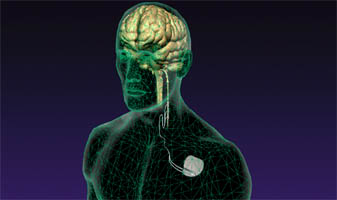The statistics are stark and sobering— and for the uninitiated (which is to
say most of us), startling. Epilepsy in America is as common as breast cancer,
and takes as many lives. A mysterious and widely misunderstood affliction,
epilepsy is a disorder in which the brain produces sudden bursts of electrical
energy that can interfere with a person's consciousness, movements or
sensations. Up to 50,000 Americans die each year from seizures and related
causes, including drownings and other accidents; one in 10 people will suffer a
seizure in their lifetimes. By some estimates, the mortality rate for people
with epilepsy is two to three times higher—and the risk of sudden death is 24
times greater—than that of the general population. There are 200,000 new cases
each year, and a total of more than 3 million Americans are affected by it—more
than multiple sclerosis, cerebral palsy, muscular dystrophy and Parkinson's
disease combined. Between 1 and 3 percent of the population will develop some
form of epilepsy before age 75.
(Article continued below...)
There is also a rise expected in the incidence of epilepsy among the veterans
of the wars in Afghanistan and Iraq who have sustained traumatic head injuries.
Yet public and private funding for research lag far behind other neurological
afflictions, at $35 a patient (compared, for instance, with $129 for Alzheimer's
and $280 for multiple sclerosis). It is time to remedy that gap, and to raise
epilepsy to the front ranks of public and medical concern.
There is cause for hope. Science is unraveling more and more of the mysteries
of the brain, and perhaps the source of the cataclysmic electrical storms of
epilepsy will yield its secrets. Such, at least, is the aim of Sen. Edward M.
Kennedy, who is considering a major bill to support enhanced research that will
fund more work toward a cure, and of a resolute band of advocates that includes
the man who sits nearest the Oval Office in the West Wing. White House senior
adviser David Axelrod and his wife, Susan, are the parents of Lauren, a
27-year-old who began suffering seizures when she was 7 months old. Mrs.
Axelrod, who contributes a piece in the following pages, is a founding board
member and president of CURE—Citizens United for Research in Epilepsy. The
group's mission is clear from the acronym: to learn everything we can about
epilepsy in search of a cure.
Epilepsy is an ancient brain disorder, and different cultures at different
times have veered between considering it a disease or thinking of it as a sign
of demonic possession. Around 400 B.C., Hippocrates defined it as a physical,
not a spirit, affliction, writing of what was then called "the Sacred Disease":
"It appears to me to be nowise more divine nor more sacred than other diseases,
but has a natural cause like other affections." Julius Caesar suffered from it;
Jesus cured people with epilepsy in Gospel accounts of his ministry. The word
itself is derived from the Latin epilepsia, which means "to take hold of." In
1604, Shakespeare has Othello suffer a kind of seizure as Iago works him into a
frenzy of jealousy: "My lord is fall'n into an epilepsy," Iago tells Cassius.
Seizures played a role in convicting suspected witches through the ages. Well
into the 20th century, some states had sterilization laws that applied to people
with epilepsy, and several more forbade those with epilepsy from marrying. In
1956, Roscoe L. Barrow and Howard D. Fabing published "Epilepsy and the Law: A
Proposal for Legal Reform in the Light of Medical Progress," a book that helped
lead to the repeal of many sterilization and antimarriage laws.
Though the most overt examples of discrimination and demonization have faded
with time, epilepsy still receives too little attention, either from the medical
community or the public at large. Why? One reason is that advances in drug
treatments have created the popular impression that epilepsy is now an
essentially manageable condition. (Which, for two thirds of patients, it is. But
that still leaves a third for whom it is not.) It is thought to be rarely fatal,
controllable by medication. There is a terrible irony here: because most people
with epilepsy are not in a constant state of seizure—they are, rather, in
perpetual but quiet danger—their condition can appear less serious than it truly
is. It is all too human, but all too true, that a problem, including the problem
of a serious medical affliction, stays out of mind when it is out of sight.
Because so many of those who must endure it do so valiantly, and with grace
and grit, it is more difficult for those not directly affected by it to grasp
that epilepsy can kill. Put harshly, we need more of a cancerlike sensibility
around epilepsy. We cannot usually see our friends' cancer, but we do not
hesitate to invest the search for a cure for different cancers with the utmost
cultural and political importance. We must now do the same with epilepsy. "We
want complete freedom from seizures," says Susan Axelrod. "We want future
families to be spared what so many other families, for so many years, have
endured. Lives should not be defined by diseases." No, they should not—which is
why all of us must focus on understanding epilepsy. And then we must defeat
it.
http://www.newsweek.com/2009/04/10/a-storm-in-the-brain.html